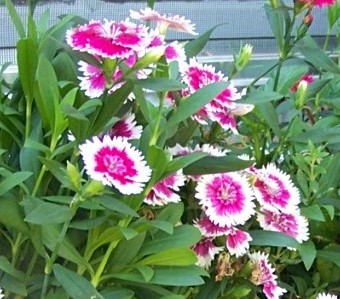You can eventually get pretty far down with hardpan, particularly if you put some muscle into it. Gardeners who want plants to put down deep roots or who want to put in a tree but don't want to dig and scrape for what seems like forever can rent a power digger or hire a professional to do this sweaty job.
B is for bedrock
In some areas, not even scraping the soil gets the hole deeper. It is possible that you have bedrock — a layer of some type of rock underneath the soil.
It is tempting to try to plant in the softer soil above hardpan or bedrock. But it's not wise. When water comes in — hose water or rain — it sits above the hardpan or bedrock almost as if its contained in a bowl. The roots reach down until they are blocked by the hardpan or bedrock. Then they become waterlogged, and if the situation continues, the roots will eventually rot.
In warm weather, hardpan and bedrock cause additional problems. Plant roots, instead of reaching deep into the soil, are confined above the hard layer, in a shallow layer of soil. Being shallow, the soil dries out very quickly and plants wilt very soon after being watered.
How high is the water table?
Natural water under the earth can be very deep down or almost just below the surface. When it rises above the surface, as in streams or floods, you can easily see it. But if the water is just below the surface you don't notice it or even think about it. That is, until you start digging a planting hole. In addition to other drainage problems, you may see water seeping into your hole. You will either have to plant in another way (in a pot or a sunken container, for example) or consider installing some type of drain line.
Basically, a drain line is a downhill trench with the high point at your targeted planting area and the low point where you want the water to emerge. The trench will have to be lined and pipes installed. You may prefer to use a professional landscaper for this job.
Dealing with drainage problems
Dealing with drainage problems depends on what you want to plant. If you have hardpan, dig down to a minimum of 30 centimeters for a small plant and 1 meter for a small tree. Replace all soil with good topsoil. For a deep-rooted plant such as a tree, you may want to dig down as far as possible, fill the hole with good soil, and then create a raised mound about 60 centimeters high. Alternatively, use containers or raised beds.
Masterminding mulch
MULCH IS ANYTHING that can be put on the surface of the soil without Injuring the plants. Mulch reduces topsoil erosion, helps keep soil from baking In the sun and drying in the wind, and discourages the sprouting and growth
of many weeds. Mulch also helps limit soil movement during the winter Sudden /lasts, alternating with sudden thaws, make the soil shift, disturbing plants. In the vegetable patch, mulch scattered underneath such plants as cucumbers, marrows, or unstaked tomatoes acts as a cushion. This cushion decreases vegetable contact with damp ground, a situation that encourages rot.
When to mulch
In deter weeds, apply mulches in early spring before seeds sprout, or germinate. To control water loss during hot summer months, apply mulches after the ground warms tip in spring. If you place a mulch too early, the soil stays cool and plant growth slows. [his particularly affects vegetables such as corn, cucumbers, melons, and early-ripening tomatoes, which need warmth for a good start. To protect more delicate plants from winter frosts, apply mulch straight after the first hard frost of the season.
Do not apply mulch on seeded areas or around emerging seedlings. This will encourage damping off, eliminating qourtinq new plant growth almost overnight.
If you're growing seedlings, wait until they have become reasonably sturdy before you start mulching around them.
Picking the perfect mulch
As with soil improvers, lots of different substances might be used as a mulch. Some are organic and some are not. The best mulches are inexpensive, easy to get, and easy to use. Organic mulches disintegrate over time, but you can then dig them into the soil, which is quite beneficial.
Mulches can be made from all manner of substances, such as spent mushroom compost, rotted garden compost, chipped bark, shredded bark, and coconut shells. There are even decorative mulches, such as gravel, pebbles, or glass beads. I'm going to go into a bit more detail about mulches on the next few pages.
You can visit this flower guide for more information about this article.

